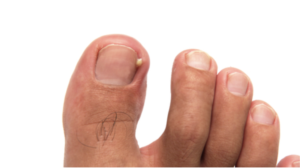COMMON CONDITIONS
Ingrown Toenail | Why Ingrown Toenail happen | Causes | Treatment | Doctor near you IN RICHARDSON, DALLAS, GARLAND, WYLIEM, MURPHY.
What is an Ingrown Nail?
It is important to first know the signs and symptoms of an ingrown and determine the cause.
Ingrown toenail happen when a nail is curved and grows into the skin, usually at the nail borders (the sides of the nail). This digging in of the nail irritates the skin, often creating pain, redness, swelling, and warmth in the toe.

Consequently, if you get an ingrown toenail then you can have following affects on your body:
- It causes a break in the skin and bacteria may enter and cause an ingrown toenail infection in the area, which is often marked by drainage and a foul odor.
- Even if your toe is not painful, red, swollen, or warm, a nail that curves downward into the skin can progress into an infection.
- Ingrown toenail may cause severe pain
- Ingrown toenail in the setting of diabetes can turn from bad to worse.
Now that you can spot an ingrowing nail, we will discuss what causes nails to get ingrown.
Ingrown toenail Causes
There certain factors which lead to the disorder. These factors include:
- Heredity: In many people, the tendency for the disorder of toenail is inherited.
- Trauma: Sometimes an ingrown toenail is the result of trauma, such as stubbing.
- Repeated Pressure: Engaging in activities that involve repeated pressure on the toes, such as kicking or running.
- Improper trimming: The most common cause of ingrown toenails is cutting your nails too short or improperly. This encourages the skin next to get irritated and begin to grow over the nail.
- Improperly sized footwear: One of the causes of Ingrown toenails is wearing socks and shoes that are tight or short.
- Nail conditions: Ingrown toenails can be caused by nail problems, such as fungal infections or losing a nail due to trauma.
After knowing the causes of the disorder, here is how to treat an ingrown toenail and how to relieve pain associated with an ingrown toenail
The treatment of the disorder includes different methods like home care and physician care, discussed bellow:
Home Care treatment of Ingrown Toenail:
Ingrown toenail home remedy is one of the treatment methods applied before visiting to any doctor. If you do not have an infection or significant medical conditions that put your feet at risk (such as diabetes, nerve damage in the foot or poor circulation), ingrown toenail remedy include soaking your foot in room-temperature water (adding Epsom salt may be recommended by your doctor) and gently massage the side of the nail fold to help reduce the inflammation.
Avoid attempting “bathroom surgery”. Repeated cutting of the nail can cause the condition to worsen over time. If your symptoms fail to improve, it is time to see a foot and ankle doctor.
Physician Care for ingrown toenail:
The physician examines the ingrown toenail and come up with different treatment methods for the disorder.
Infection ingrown toenail treatment:
After examining the toe, we will select the treatment best suited for you. If an infection is present, an oral antibiotic may be prescribed. Other form of treatment of ingrown toenail involves minor surgery.
Ingrown toenail matrixectomy: Sometimes a minor surgical procedure known as ingrown toenail matrixectomy, performed in the office, will ease the pain and remove the offending nail. After applying a local anesthetic, we remove part of the nail’s side border. Some nails may become ingrown again, requiring permanent removal of the offending edge.The rest of the nail is kept intact and will grow normally. This procedure permanently resolves the issue and the rate of a recurrent ingrown nail after this procedure is less than 10%. Following the nail procedure, a light bandage will be applied. Most people experience very little pain after surgery and may resume normal activity the next day. If we prescribed an oral antibiotic, be sure to take all the medication, even if your symptoms have improved.
Keep in mind that, if not treated well, ingrown toenail keeps coming back. So take care of yourself and your toe.
Ingrown Toenail | Why Ingrown Toenail happen | Causes | Treatment | Doctor near you IN RICHARDSON, DALLAS, GARLAND, WYLIE, MURPHY.
Dr. Raymond Delpak works with patients to determine the best course of action for treating foot and ankle problems. We use the most advanced techniques possible. If you would like to learn more, please visit us TX Foot and Ankle Consultants or schedule an appointment.
SUBSCRIBE TO OUR NEWSLETTER
*for updates on our medical equipment only

